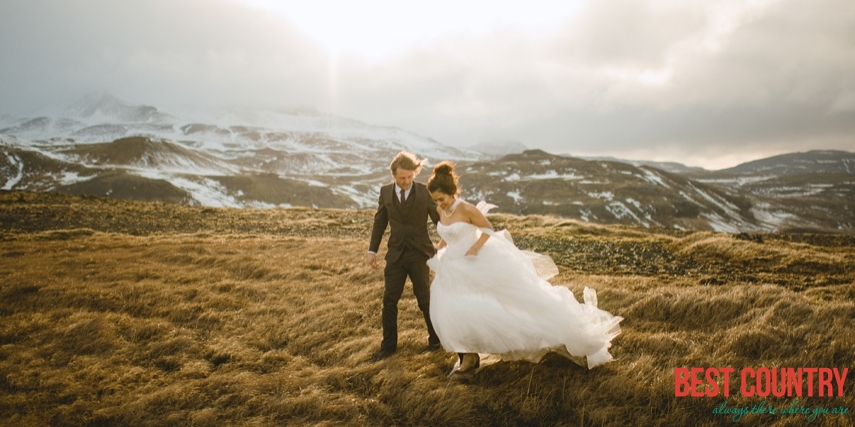Marriage is a very serious business in Iceland. Couples are not urged to rush into matrimony. Long engagements are the norm, sometimes three or four years.
Wedding Traditions in Iceland
Today Icelanders have adopted American and European wedding traditions for the most part, but the traditional Icelandic weddings traditions were far more elaborate.
In years gone by, Icelandic weddings could last for a week at a time, often in the bride’s home or the church in the bride’s hometown.
Before the marriage the couple’s engagement would have to be publicly declared on three separate occasions, usually in a church.
The first time was often in the bride’s church, the second time in the groom’s church and the third time in the church in which they were to be married.
 The wedding would usually start at least one day before the actual ceremony, with lots and lots of drinking and song and speeches and merrymaking.
The wedding would usually start at least one day before the actual ceremony, with lots and lots of drinking and song and speeches and merrymaking.
Many toasts would be drunk to the happy couple, to the Virgin Mary, and to various honored guests.
Most toasts would begin with a speech or a poem and then end in song and drink. Multiple toastmasters were often hired to keep the toasts coming for days on end.
On the day of the wedding – traditionally a Sunday – the groom would arrive surrounded by the best man and his relatives and often local nobles.
As the groom approached, the church bells would be rung to announce his arrival. The groom was expected to enter the church and wait for his bride.
The bride would then walk – very slowly – through the village with her bridesmaids. She would be dressed in her finest clothes.
When she would arrive at the church the toastmaster would escort her to the groom and she and her groom would be seated on the bridal bench in the church. The ceremony would then take place, concluding with the groom placing a ring on the bride’s finger.
Following the ceremony a reception was held. The bride and groom, along with the priest who married them and the fathers and the best men and the toastmasters would sit at a high table, while the guests sat at long tables which radiated out from the high table.
Depending on how wealthy the bride and groom were the feast could be an elaborate three or four course affair or it could be a more simple smorgasbord of breads and cakes.
Before the ceremony ended, the bridesmaids would take the bride to her bridal bed and undress her, leaving her wearing only her bridal headdress.
It was customary for the groom to present his bride with a gift on the bridal bed. Today it is also common for the bride to present the groom with a wedding-bed gift.
Traditionally the bride would be waiting for her new husband wearing only her bridal headdress, which her new husband would remove.
Once the couple were in bed together the priest would bless them one last time and the couple would drink from the bridal cups to seal their marriage.
Today weddings are seldom this elaborate, or filled with this much ritual. Prior to the wedding the bride’s friends often throw her a bridal shower which is often rather vulgar in nature, and is often thrown on the same night that the groom’s friends are throwing him a raunchy bachelor party.
The actual ceremony is seldom even one day long any longer and most Icelanders pattern their weddings after the American style, with ring bearers, flower girls, and the throwing of rice following the ceremony.
The wedding reception still tends to be filled with toasts, singing, laughter, and much drinking.